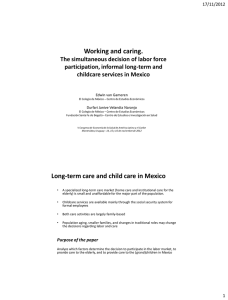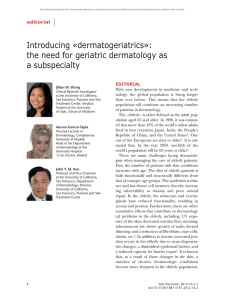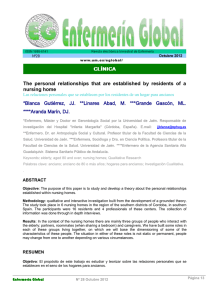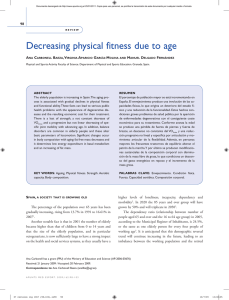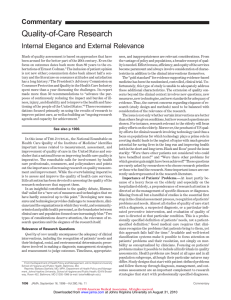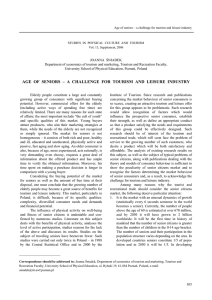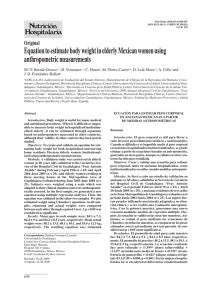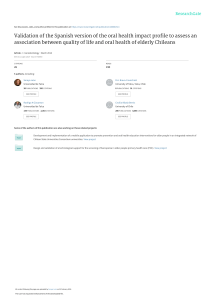Practical of physical activity between aged of the Valley of the
Anuncio
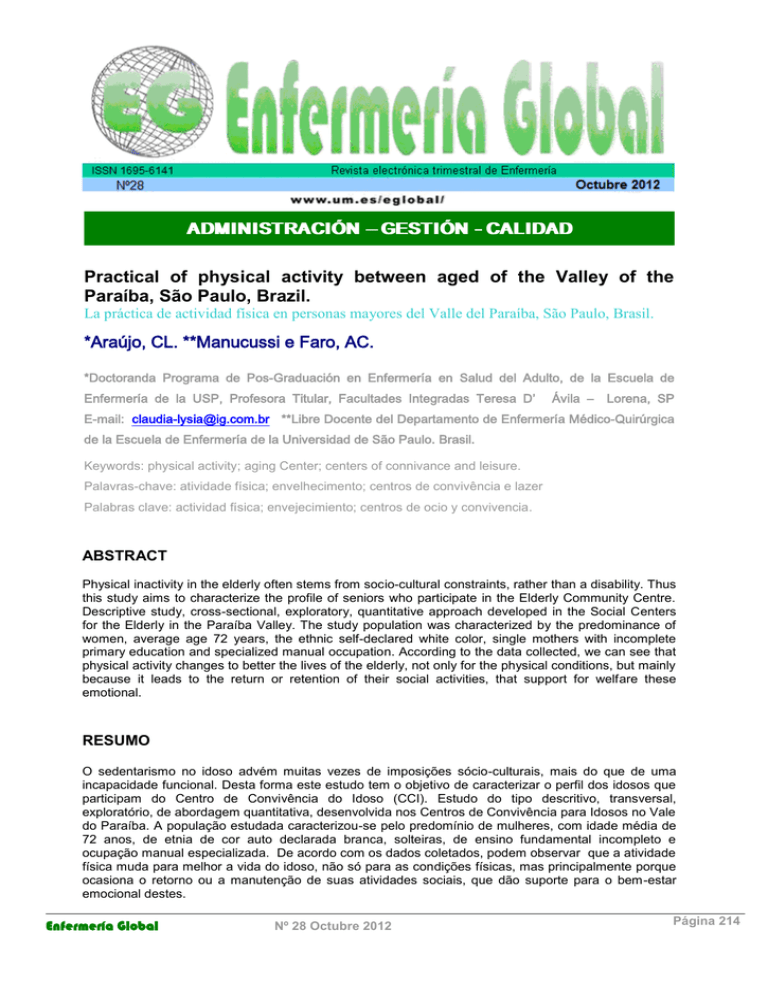
ADMINISTRACIÓN – GESTIÓN - CALIDAD Practical of physical activity between aged of the Valley of the Paraíba, São Paulo, Brazil. La práctica de actividad física en personas mayores del Valle del Paraíba, São Paulo, Brasil. *Araújo, CL. **Manucussi e Faro, AC. *Doctoranda Programa de Pos-Graduación en Enfermería en Salud del Adulto, de la Escuela de Enfermería de la USP, Profesora Titular, Facultades Integradas Teresa D’ Ávila – Lorena, SP E-mail: [email protected] **Libre Docente del Departamento de Enfermería Médico-Quirúrgica de la Escuela de Enfermería de la Universidad de São Paulo. Brasil. Keywords: physical activity; aging Center; centers of connivance and leisure. Palavras-chave: atividade física; envelhecimento; centros de convivência e lazer Palabras clave: actividad física; envejecimiento; centros de ocio y convivencia. ABSTRACT Physical inactivity in the elderly often stems from socio-cultural constraints, rather than a disability. Thus this study aims to characterize the profile of seniors who participate in the Elderly Community Centre. Descriptive study, cross-sectional, exploratory, quantitative approach developed in the Social Centers for the Elderly in the Paraíba Valley. The study population was characterized by the predominance of women, average age 72 years, the ethnic self-declared white color, single mothers with incomplete primary education and specialized manual occupation. According to the data collected, we can see that physical activity changes to better the lives of the elderly, not only for the physical conditions, but mainly because it leads to the return or retention of their social activities, that support for welfare these emotional. RESUMO O sedentarismo no idoso advém muitas vezes de imposições sócio-culturais, mais do que de uma incapacidade funcional. Desta forma este estudo tem o objetivo de caracterizar o perfil dos idosos que participam do Centro de Convivência do Idoso (CCI). Estudo do tipo descritivo, transversal, exploratório, de abordagem quantitativa, desenvolvida nos Centros de Convivência para Idosos no Vale do Paraíba. A população estudada caracterizou-se pelo predomínio de mulheres, com idade média de 72 anos, de etnia de cor auto declarada branca, solteiras, de ensino fundamental incompleto e ocupação manual especializada. De acordo com os dados coletados, podem observar que a atividade física muda para melhor a vida do idoso, não só para as condições físicas, mas principalmente porque ocasiona o retorno ou a manutenção de suas atividades sociais, que dão suporte para o bem-estar emocional destes. Enfermería Global Nº 28 Octubre 2012 Página 214 RESUMEN La inactividad física en las personas mayores a menudo se deriva de las limitaciones socio-culturales, en lugar de una discapacidad. Así, este estudio tiene como objetivo caracterizar el perfil de los adultos mayores que participan en el Centro de Convivencia de Ancianos (CCI). Estudio descriptivo, transversal, de carácter exploratorio, cuantitativo, desarrollado en los Centros Sociales para la Tercera Edad en el Valle del Paraíba. La población de estudio se caracterizó por el predominio de mujeres, con edad media de 72 años, de etnia autodeclarada blanca, madres solteras, con educación primaria incompleta y ocupación manual especializada. Según los datos recogidos, se observa que la actividad física mejora la vida de las personas mayores, no sólo por las condiciones físicas, sino sobre todo porque ocasiona la vuelta o el mantenimiento de sus actividades sociales, que son la base de su bienestar emocional. INTRODUCTION Physical inactivity among the elderly (1) often comes from socio-cultural constraints, rather than a disability. The behaviors attributed to older people refer to passivity and immobility, with a low level of physical activity. However it is known that many of the physiological and functional results observed among the elderly are due to the absence of stimulation rather than changes attributed to aging (2). Data from Brazil on the prevalence of physical activity of its population, as well as the association of physical inactivity with the socio-demographic variables (age, marital status, ethnicity, occupation, socioeconomic status etc.) and health conditions (presence or absence of diseases, diseases, health perception among others) the elderly, especially using the same evaluation measures that can support national and international comparisons and indicators of possible interventions in terms of public health (3). Physical inactivity is one of the most important risk factors for chronic diseases associated with poor diet and smoking. The modern lifestyle provides spending most of the free time in sedentary activities such as watching television. We must remember that health is not just a matter of care and access to medicines. The promotion of "healthy lifestyles" is seen by the health system as a strategic action (4). In this process, some aspects are facilitators for the incorporation of physical activity, such as encouragement of friends and family, looking for companionship or occupation, some specific programs of physical activity, and especially the guidance of health professionals encouraging the elderly to incorporate a healthier and more active lifestyle, which is a strong tendency in some regions of Brazil and Internationally. The positive aspects and consequences of physical activity for health in the elderly have been widely documented. The main benefits of biological, psychological and social performance provided by physical activity can be observed in the better functioning body, reducing the functional loss, pain, favoring the preservation of independence, maintenance of bone mineral density, lipid profile, glucose utilization and peripheral circulation, it improves posture and balance, control of blood pressure, body weight, immune response, intestinal function, quality of sleep, sex life, reduces risk of death from cardiovascular disease, anxiety, stress, increase social contact, increase in improved mood and self-esteem. Enfermería Global Nº 28 Octubre 2012 Página 215 A person who ceases to be sedentary decreases by 40% their risk of death from cardiovascular disease and associated with a proper diet it can reduce the risk of the progression of type II diabetes by 58%, demonstrating that a small change in behavior can cause a major improvement in health and quality of life (4). Physical activity should be easy and not cause injury. It should be low impact and occur at moderate intensity meaning that the subjective perception of effort increases heart rate and / or respiratory rate, allowing the individual to breathe without difficulty and with increasing body temperature. Resistance exercise or muscle strength training contributes to decreasing the incidence of falls and maintains bone density (4). Strength exercises are those that can actually slow or reverse some form of loss of muscle mass (sarcopenia) and bone mass (osteopenia and osteoporosis), and therefore the activities are preferable for the maintenance of functional capacity and independence (4). This practice provides the individual with the opportunity to rediscover their corporeality, the possibility of re-tying your shoe-laces, cut nails, combing hair, makeup, leaving home, take a bus, meet new people, make friends, among other things. Incorporating movement to your life means a new direction to your existence, it means in other words, spending more time careing for youself. With the progression of age, individuals become less active, their physical capabilities diminish, begining to show the feelings of old age and physical inactivity can lead to the emergence of chronic diseases. So it should be emphasized that the practice of regular physical activity, besides contributing to improved mood and sense of wellbeing, brings a reinforcement to the self-esteem due to living a healthier lifestyle and seeking a better quality of life. In addition, physical activity has a beneficial effect on the quality of life of patients with depression, intermittent claudication, coronary heart disease and multiple organ dysfunction(5). In this context, it is important to know their socio-demographic characteristics, health conditions and physical activity level, because these aspects of older people’s lives can make early or late changes in aging associated with prevalence of chronic diseases. From the knowledge of this reality, economic and social resources can be invested in areas that may be needed for longer to keep the functional capacity of older people, such as deployment and / or implementation of programs of physical activity and social work (5). The Ministry of Health in Brazil in the light of proposals by the World Health Organisation (WHO) has proposed public policies related to population aging and asset quality. So several programs in the country are aimed at the development of physical activity, improving functional capacity and social integration of older people. From the perspective of gerontological nursing, health promotion activities have as pillars for the elderly, promoting active and healthy aging, preserved their maximum functional capacity. To that end, it takes more than access to quality medical care, we need public policies for intersectoral coordination of government and society. Nursing has interdisciplinary knowledge and operates with unique abilities and professional skills. The nurses in Brazil give sustainability to health promotion and disease prevention programs due to public policies implemented in many more distant points. Enfermería Global Nº 28 Octubre 2012 Página 216 Thus this study aims to characterize the profile of participating seniors in the Elderly Community Centre regarding sex, age, occupation, marital status, self-reported ethnicity, occupation, monthly individual income, education, family composition, place of birth and origin, living conditions, means of transportation used to leave home and go to the Elderly Community Centre, leisure physical activity, comorbidities, and treatments reported. METHOD The study is an exploratory, descriptive, cross-sectional quantitative approach, developed with the elderly participating in the project from the Elderly Community Centre in the Paraíba Valley, State of São Paulo, south eastern Brazil. The total population of the elderly of seven cities is 40,928. We established inclusion and exclusion criteria for the selection of elderly people who could participate in the study, which resulted in 2.339 individuals. To collect data and a sample size, a calculation was performed with computational significance of 5%, resulting in the number of 386 elderly, who, aas a goup, comprised the sample of this research. Inclusion criteria was: to be less than 60 years old, to have been at the Elderly Community Centre from between three months and one year. This was the search field able to respond consistently to instruments of data collection. The cities were chosen for convenience of the researcher. The convenience sampling(6) is formed by members of the population with greater willingness to research or with easy access. For data collection, the technique of applying assisted questionnaire as an interview was adopted, obtaining information on sociodemographics, health status, classification ¬ economic development of mica and physical activity. The questionnaire was composed of variables such as sex, age, occupation, marital status, self-reported ethnicity, occupation, monthly individual income, education, family composition, birth and origin, living conditions, means of transportation used to leave home and go to the Elderly Community Centre, and leisure physical activity, comorbidities, and treatments reported. Data was collected during the months of December/2009 and January/2010 by the researcher, through semi-structured interviews. We respect all ethical disciplines by Resolution 196/96 of the National Health Council in Brazil, on research involving human subjects, emphasizing that the project was approved by the Ethics Committee in Research of the College Teresa D’Àvila (Opinion no. 87/2009). All elderly participants signed a consent form in duplicate. RESULTS AND DISCUSSION The study population (n = 386) was characterized predominantly by women, mean age 72 years, ethnic self-declared white, single, primary education and specialized manual occupation. These data are detailed in Table 1. Enfermería Global Nº 28 Octubre 2012 Página 217 Table 1: Distribution of elderly participants (N = 386) according to sex, marital status, education and profession. Valley of the Paraíba, 2009/2010. Variables Sex Female Male Marital status Single Married Separated Divorced Widower Cohabitation Education Illiterate Literate Elementary school Complete basic education Profession Manual unskilled occupation Specialized manual occupation Positions related to supervision No occupation No occupation defined Elderly participants N Percentage 309 80,1% 77 19,9% 139 92 69 44 29 13 36,0% 23,8% 17,9% 11,4% 7,5% 3,4% 6 111 178 91 1,6% 28,8% 46,1% 23,6% 108 155 89 28 6 28,0% 40,2% 23,1% 7,3% 1,6% In Brazil, the complete number of elderly women over 65 years old is higher than in men. This stems from the existence of differential mortality by sex for a long time that prevails in the Brazilian population, because, since 1950, women have had longer life expectancy. The world average for life expectancy at birth was 65 years in 2000 and is expected to reach 74.3 years in 2045 and 2050 (7). Studies (3,8,9,10), held in Elderly Community Centre, it was found that it was mostly older women who participated in Elderly Community Centre. In Elderly Community Centre(8.9), the most prevalent age group was over 70 years. Other authors (11,12) showed that in their study of the Elderly Community Centre predominance of females, there were many widows with formal schooling until the end of the first degree. In the survey (9) which dealt with women aged 59-77 years of an Elderly Community Centre in the metropolitan region of Belo Horizonte, in order to learn the myth of desexualization and emotional life of the elderly, it was concluded that the majority (52.83 %) of the women had had three or more children. With respect to literacy (4) in a study of 197 elderly indicates that most patrons of community groups in Belo Horizonte is literate. The results concerning the level of education reflect an aspect of social inequality in the country. The illiteracy situation may itself be considered a limiting factor for the survival and quality of life. The differences in literacy levels, gender, social organization reflect the beginning of the century that blocked access to school for the poor and women. The wide access to media literacy, as well as a matter of citizenship, Enfermería Global Nº 28 Octubre 2012 Página 218 could provide greater receptivity on the part of elderly, the health education programs, and also some protection against cognitive dysfunction that often affect (13). As for ease, 227 seniors (58.8%) were from the city itself, whereas local data collection claimed that the remaining 159 (41.2%) were from nearby cities to a radius of about 400 km. The housing of the 269 seniors (69.9%) was owned, to 101 elderly (26.2%) was rented and the remaining 16 (3.9%) was borrowed housing or lived with another family. Family income was the minimum wage for 309 elderly (80.1%) and the remaining 77 elderly (19.9%) received between two and five times the minimum wage. The pensions are in fact the main source of income for the elderly in urban areas, but as these are usually very low, some seniors are forced to work as a means of subsistence(14). Financial independence is an essential factor of independence among older people, positively influencing their quality of life. This is corroborated when we observe that 71% of seniors who attended the "ball" at Senac of Maringá (PR), claimed to have complete freedom to manage their financial resources (15). The families of 134 elderly (34.7%) were composed of three people, 112 elderly (29.0%) had four people and the other 140 seniors (36.3%) had up to six people. The elderly respondents 130 (33.7%) had three children, 110 (28.5%) had two children and the other from zero to five children. The means of transportation to go to the Elderly Community Centre for 262 elderly (67.9%) were on foot, for 81 elderly patients (21%) it was by car, for 29 elderly people (7.5%) by bus and for 14 elderly (3, 6%) by bicycle. It was reported that 93 seniors (24.1%) had diabetes mellitus, 81 elderly patients (21.0%) had hypertension, 81 elderly patients (21.0%) had no disease, 59 elderly (15.3%) had diabetes and hypertension and 72 elderly (18.6%) had other diseases. In one study(16) conducted in Canada showed that people at risk of developing type II diabetes may decrease the risk by 58% by exercising moderately for 30 minutes per day and losing 5-7% of body weight. In people over 60 years, the risk can be reduced by 71%. Physical activity (16) is very important in controlling diabetes. Participation in regular programs of physical activity can improve glucose levels in the blood of older people with diabetes. Table 2: Distribution of elderly participants (N = 386) a second physical activity, physical activity and leisure activities 2. Valley of the Paraíba, 2009/2010. Variables Physical activity (1) Walking Dancing Adapted volleyball Other activities Physical activity (2) Walking Enfermería Global Elderly participants N Percentage 181 46,9% 85 22,0 63 16,3 57 14,8% 103 Nº 28 Octubre 2012 26,7% Página 219 Dancing Adapted volleyball Other activities Leisure activities Painting Crochet Playing cards Sewing Handicraft 97 72 114 25,1% 18,7% 29,5% 69 124 75 64 54 17,9% 32,1% 19,4% 16,6% 14,0% Of the elderly participants of this research, 305 seniors (79.0%) were participating in two physical activities, whilst only 81 elderly (21.0%) perform just one type of physical activity. It is noteworthy that one physical activity refers to an activity preference and two proposals are complementary activities. Exercise is a subset of physical activity, planned in order to improve or maintain fitness, muscular endurance and flexibility. This valuation of exercise for the aged is key to help them live well and better from the point of view of physical and mental health(17). The increase in life expectancy refers to more confidence in aging and greater interest in initiating physical activity programs, since they allow the extension of the time spent living independently and activity in the elderly. Some factors, such as the difficulties of starting a physical activity are the same that can improve and enhance the development of these activities, such as general health, functional independence, pain, fatigue and physical appearance. Social contact is extremely important for the elderly, programs for the group are more likely to stimulate the aged to continue participating. The groups become stress reducers, helping the elderly to maintain a positive life in the face of decreased energy and the difficulties that arise with aging (5). Studies confirm that maintenance of functional capacity and autonomy in aging are significantly influenced, among other factors, by regular physical activity and efficiency of a physical activity program for seniors, this depends significantly on the evaluation of their current conditions and peculiarities of the elderly person or groups of elderly in question (18). Table 3: Distribution of elderly participants (N = 386) according to sex of the elderly participate in two physical activities. Valley of the Paraíba, 2009/2010. Variables Participate in two activities Female Male Elderly participants No 67 14 Yes 242 63 For associations between the performances of two physical activities with the sociodemographic, the chi-square clinical test was used. The associations between the variables were studied and we observed a significant association between physical activity achieved between being unmarried, Caucasian and having a specialized manual occupation. The Universities of the Third Age(19) found that among those enrolled, approximately 80.0% were female, commenting that the greater inclusion of women could be related Enfermería Global Nº 28 Octubre 2012 Página 220 to issues of gender construction in our culture. Importantly, encouragement and provision of recreation and leisure activities are often effective strategies to reduce isolation and improve the integration of the elderly in the social environment and the development of new skills, which may result directly in improved self-esteem and health status, developing projects for community centers, seniors gathering in cultural activities, leisure and sports under the supervision of qualified professionals representing an alternative intervention for the purpose of social recovery. CONCLUSION In this study we found a profile with the predominance of an elderly woman, single, average age of 72 years old, who in addition to joining the groups, performs one or more physical activities always seeking to promote health, doing this either alone or under the initiative of the doctor. According to the data collected, we can see that physical activity changes the lives of the elderly for the better, not only by improving their physical conditions, but mainly because it causes the return or maintenance of their social activities, that support their emotional well-being. The better interaction with other seniors and senior staff accompanying them is inserted it into the society, giving them a perception of quality of life plus physical, emotional and spiritual well-being. REFERENCES 1 Spirduso, W.W. Physical Dimensions of Aging. Human Kinetics Publishers, Champaign, Illinois. 1995. 2 Barry H. C.; Eathorne, S.W. Exercise and aging. Issues for the practitioner. Medical Clinics North America, 1999. 357-375. 3 Mazo, G. Z., Liposcki D. B., Ananda, C., Prevê, D. – Condições de saúde, incidência de quedas e nível de atividade física dos idosos. Rev. Bras. Fisioter. 2007. v.11 n.6 São Carlos Nov./dez. 4 Mota, J.; Paiva, P.; Silva, S. Effects of a 6 month programme of nom specific physical activity on physical capacity of aged sedentary women. Journal of Human Movements Studies, 1995. 243-254 5 Matsudo SM, Barros Neto TL. Efeitos benéficos da atividade física na aptidão física e saúde mental durante o processo de envelhecimento. Rev Bras de Atividade Física e Saúde 2000;5(2):60-76. 6 Brevidelli M.M.; Domenico E.B.L. Trabalho de Conclusão de Curso: Guia Prático para Docentes e Alunos da Área da Saúde. 2006. 1ª Ed. São Paulo: Iátria, cap. 2. 7 Instituto Brasileiro de Geografia e Estatística. Projeção da população do Brasil: Brasil já tem mais de 180 milhões de habitantes. Brasília (DF); 2008. 8 Santos, A. M., Andrade, E. J., Almeida, J. B., Giaretta, V. M. A. – A importância do exercício físico para a terceira idade. XI Encontro Latino Americano de Iniciação Científica e VII Encontro Latino Americano de Pós-Graduação – Universidade do Vale do Paraíba, 2007. 9 Castro, N. M. S., Reis, C. A. C. - Sexualidade na terceira idade: não posso, não quero ou não devo. O mito da dessexualização das idosas e a influência da estereotipia negativa as mesmas e suas conseqüências na vida afetiva e sexual. Rev de Iniciação Científica Newton Paiva 2001 – 2002. Enfermería Global Nº 28 Octubre 2012 Página 221 10 Lazzarotto, A. R., Kramer, A. S., Hädrich, M., Tonin, M., Caputo, P., Sprinz, E. - O conhecimento de HIV/aids na terceira idade: estudo epidemiológico no Vale do Sinos, Rio Grande do Sul, Brasil. Ciênc. saúde coletiva. 2008. v.13 n.6 Rio de Janeiro nov./dez. 11 Santos, S. R., Santos, I. B. C., Fernandes, M. G. M., Henriques, M. E. R. M. Qualidade de vida do idoso na comunidade: aplicação da Escala de Flanagan. Rev. Latino-Am. Enfermagem. 2002 v.10 n.6 Ribeirão Preto nov./dez. 12 Silva, R. M. O. , Faro,A.C.M.e. A sexualidade no envelhecer: um estudo com idosos em reabilitação. Acta Fisiátrica. 2003, 10(3): 107-112. 13 Veras RP. País jovem com cabelos brancos: a saúde do idoso no Brasil. Rio de Janeiro: Relume Dumará; 1994. 14 Berquó E. Algumas considerações demográficas sobre o envelhecimento da população no Brasil. In: Anais do 1º Seminário Internacional EnvelhecimentoPopulacional: uma agenda para o final do século; 1996 jul 1-3; Brasília (DF), Brasil. Brasília (DF):MPAS/SAS; p. 16-34. 15 Marcon SS, Carreira L, Waidman MAP, Andrade OG. O cotidiano do idoso e suas relações familiares revelando indícios de qualidade de vida. Texto Contexto Enferm 1999; 1(1):213-32. 16 Powers, Alvin C. Diabetes Mellitus. In: FAUCI, Anthony S. et al. (Ed.). Harrison: princípios de Medicina Interna. 15. ed. São Paulo: Guanabara Koogan, 2002. P. 21862208. 17 Sarkisian CA, Prohaska TR, Wong MD, Hirsch S, Mangione CM. The realationship between expectations for aging and physical activity among older adult. Journal of General Internal Medicine 2005;20 (10):911-5. 18 Silveira SC, Faro ACM, Araújo CLO. Atividade física, manutenção da capacidade funcional e da autonomia em idosos: revisão de literatura e interfaces do cuidado. Estud. interdiscipl. envelhec., Porto Alegre, v. 16, n. 1, p. 61-77, 2011. 19 Veras RP. Terceira idade: um envelhecimento digno para o cidadão do futuro. Rio de Janeiro: Relume Dumará/Universidade Aberta da Terceira Idade/Universidade do Estado do Rio de Janeiro; 1995. ISSN 1695-6141 © COPYRIGHT Servicio de Publicaciones - Universidad de Murcia Enfermería Global Nº 28 Octubre 2012 Página 222
